Assignment on Growth of Social Media
VerifiedAdded on 2020/05/01
|9
|2770
|28
AI Summary
Contribute Materials
Your contribution can guide someone’s learning journey. Share your
documents today.
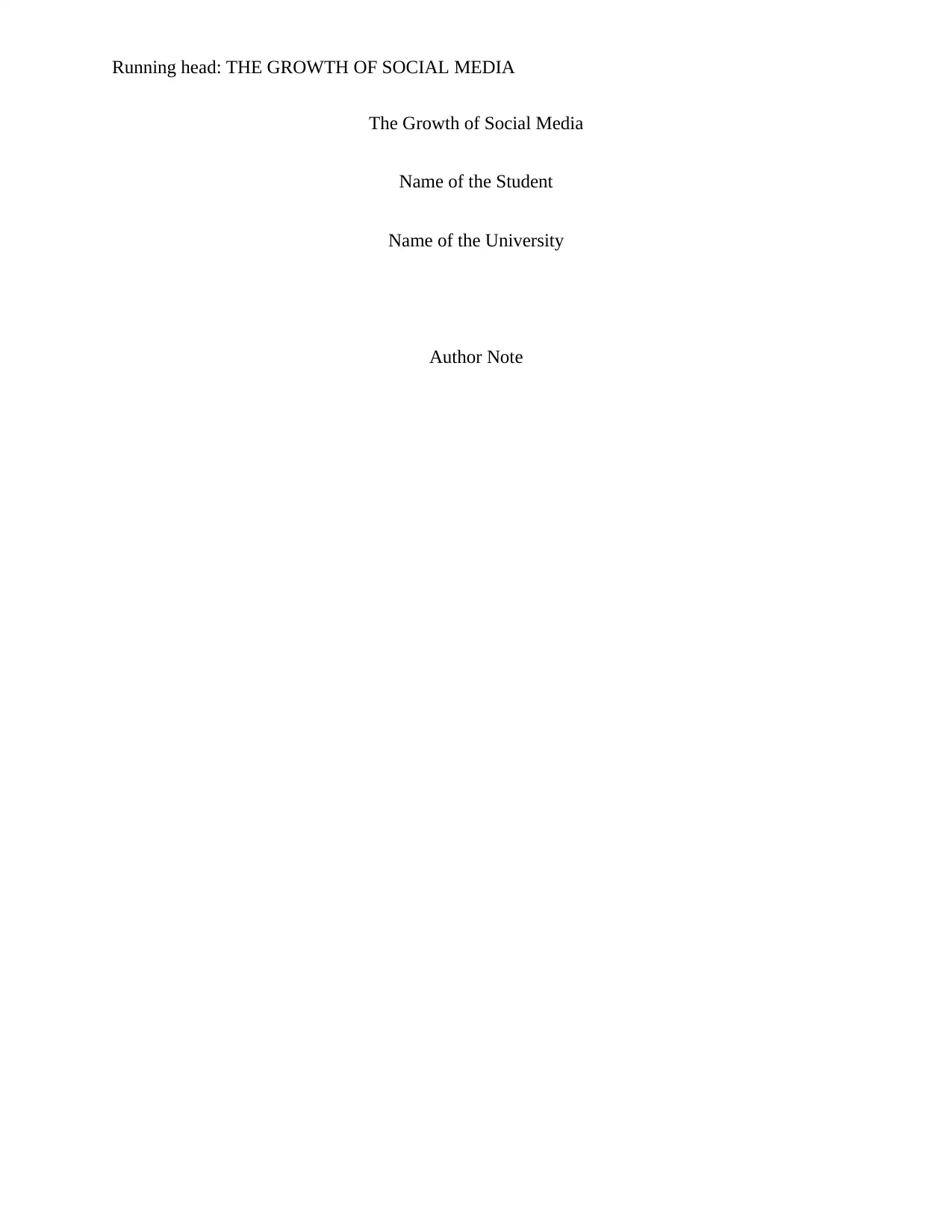
Running head: THE GROWTH OF SOCIAL MEDIA
The Growth of Social Media
Name of the Student
Name of the University
Author Note
The Growth of Social Media
Name of the Student
Name of the University
Author Note
Secure Best Marks with AI Grader
Need help grading? Try our AI Grader for instant feedback on your assignments.
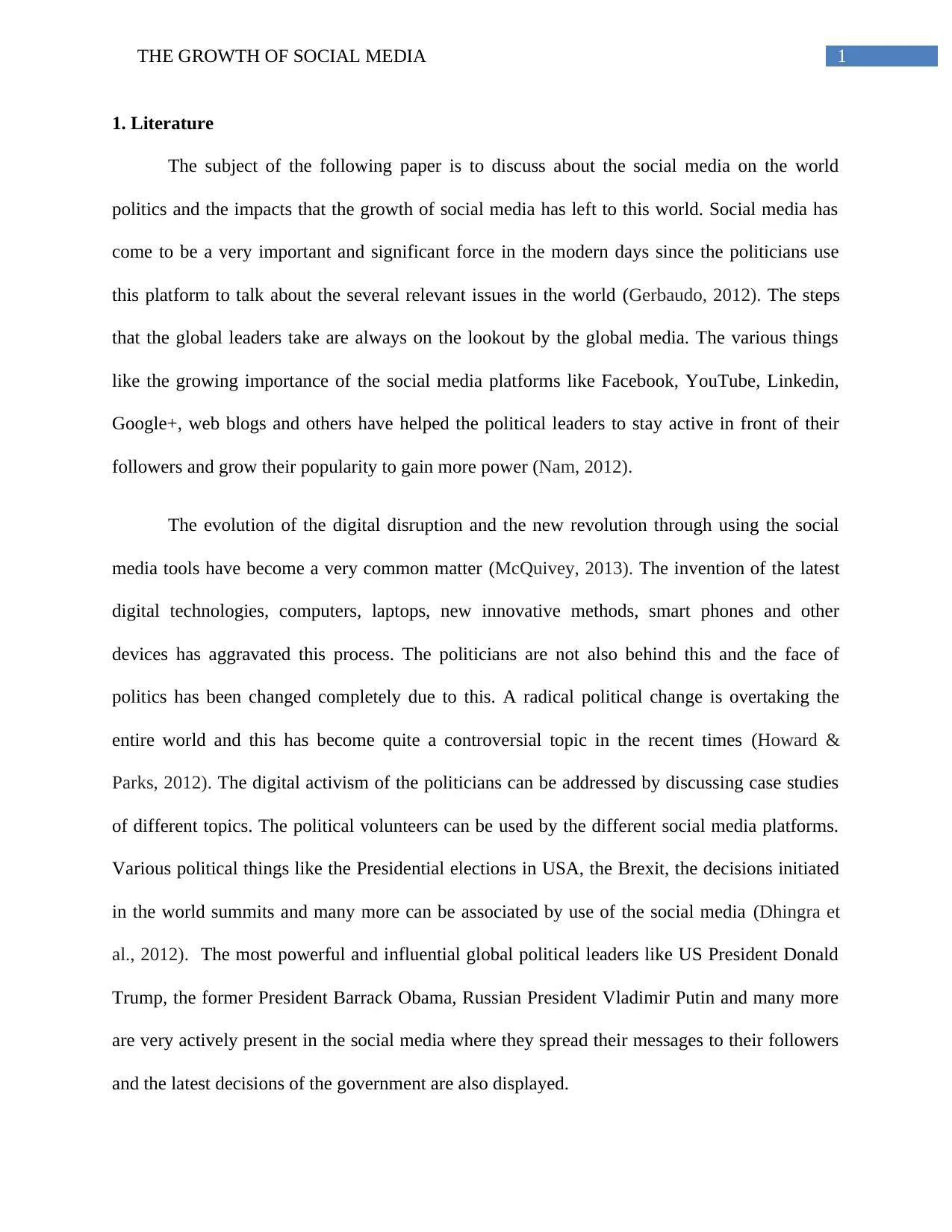
1THE GROWTH OF SOCIAL MEDIA
1. Literature
The subject of the following paper is to discuss about the social media on the world
politics and the impacts that the growth of social media has left to this world. Social media has
come to be a very important and significant force in the modern days since the politicians use
this platform to talk about the several relevant issues in the world (Gerbaudo, 2012). The steps
that the global leaders take are always on the lookout by the global media. The various things
like the growing importance of the social media platforms like Facebook, YouTube, Linkedin,
Google+, web blogs and others have helped the political leaders to stay active in front of their
followers and grow their popularity to gain more power (Nam, 2012).
The evolution of the digital disruption and the new revolution through using the social
media tools have become a very common matter (McQuivey, 2013). The invention of the latest
digital technologies, computers, laptops, new innovative methods, smart phones and other
devices has aggravated this process. The politicians are not also behind this and the face of
politics has been changed completely due to this. A radical political change is overtaking the
entire world and this has become quite a controversial topic in the recent times (Howard &
Parks, 2012). The digital activism of the politicians can be addressed by discussing case studies
of different topics. The political volunteers can be used by the different social media platforms.
Various political things like the Presidential elections in USA, the Brexit, the decisions initiated
in the world summits and many more can be associated by use of the social media (Dhingra et
al., 2012). The most powerful and influential global political leaders like US President Donald
Trump, the former President Barrack Obama, Russian President Vladimir Putin and many more
are very actively present in the social media where they spread their messages to their followers
and the latest decisions of the government are also displayed.
1. Literature
The subject of the following paper is to discuss about the social media on the world
politics and the impacts that the growth of social media has left to this world. Social media has
come to be a very important and significant force in the modern days since the politicians use
this platform to talk about the several relevant issues in the world (Gerbaudo, 2012). The steps
that the global leaders take are always on the lookout by the global media. The various things
like the growing importance of the social media platforms like Facebook, YouTube, Linkedin,
Google+, web blogs and others have helped the political leaders to stay active in front of their
followers and grow their popularity to gain more power (Nam, 2012).
The evolution of the digital disruption and the new revolution through using the social
media tools have become a very common matter (McQuivey, 2013). The invention of the latest
digital technologies, computers, laptops, new innovative methods, smart phones and other
devices has aggravated this process. The politicians are not also behind this and the face of
politics has been changed completely due to this. A radical political change is overtaking the
entire world and this has become quite a controversial topic in the recent times (Howard &
Parks, 2012). The digital activism of the politicians can be addressed by discussing case studies
of different topics. The political volunteers can be used by the different social media platforms.
Various political things like the Presidential elections in USA, the Brexit, the decisions initiated
in the world summits and many more can be associated by use of the social media (Dhingra et
al., 2012). The most powerful and influential global political leaders like US President Donald
Trump, the former President Barrack Obama, Russian President Vladimir Putin and many more
are very actively present in the social media where they spread their messages to their followers
and the latest decisions of the government are also displayed.
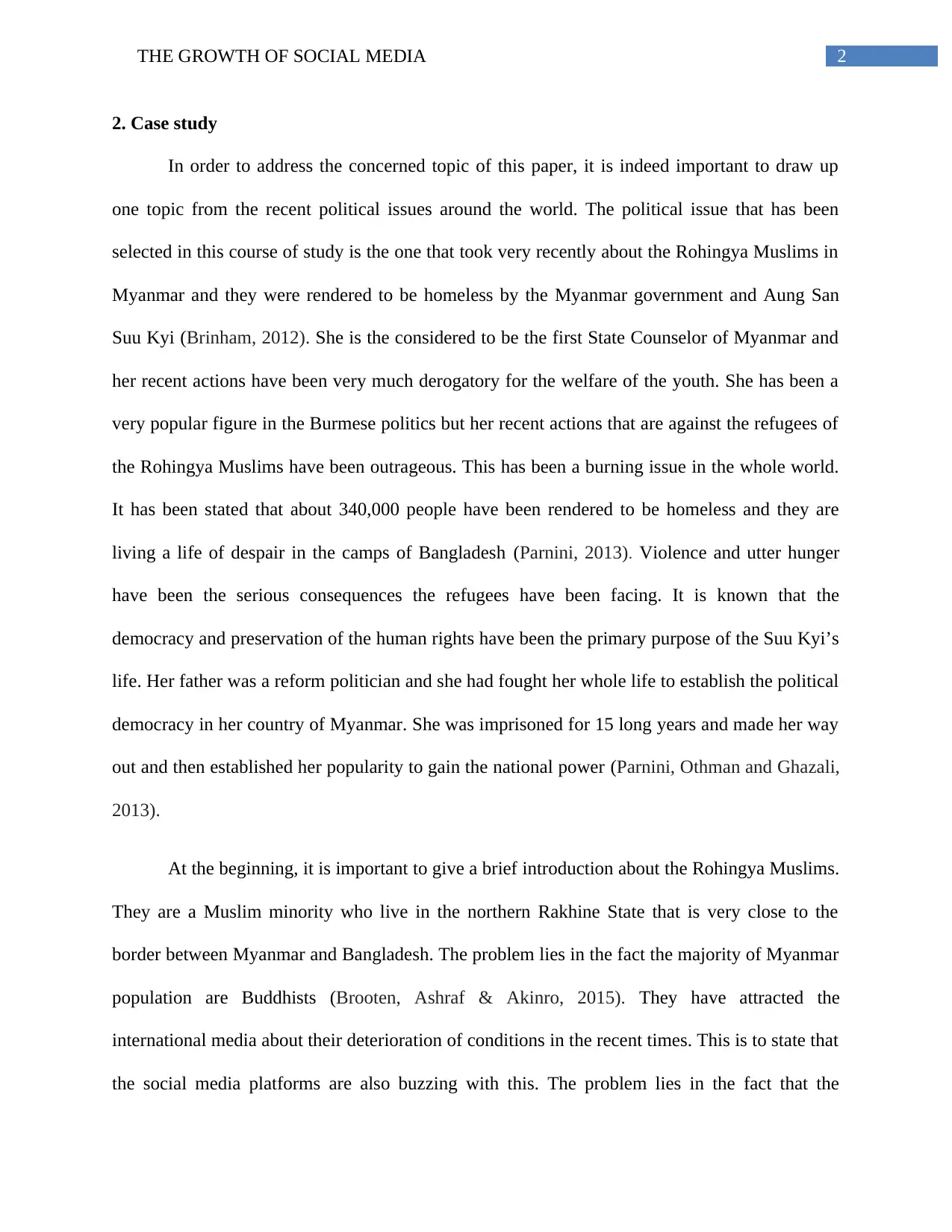
2THE GROWTH OF SOCIAL MEDIA
2. Case study
In order to address the concerned topic of this paper, it is indeed important to draw up
one topic from the recent political issues around the world. The political issue that has been
selected in this course of study is the one that took very recently about the Rohingya Muslims in
Myanmar and they were rendered to be homeless by the Myanmar government and Aung San
Suu Kyi (Brinham, 2012). She is the considered to be the first State Counselor of Myanmar and
her recent actions have been very much derogatory for the welfare of the youth. She has been a
very popular figure in the Burmese politics but her recent actions that are against the refugees of
the Rohingya Muslims have been outrageous. This has been a burning issue in the whole world.
It has been stated that about 340,000 people have been rendered to be homeless and they are
living a life of despair in the camps of Bangladesh (Parnini, 2013). Violence and utter hunger
have been the serious consequences the refugees have been facing. It is known that the
democracy and preservation of the human rights have been the primary purpose of the Suu Kyi’s
life. Her father was a reform politician and she had fought her whole life to establish the political
democracy in her country of Myanmar. She was imprisoned for 15 long years and made her way
out and then established her popularity to gain the national power (Parnini, Othman and Ghazali,
2013).
At the beginning, it is important to give a brief introduction about the Rohingya Muslims.
They are a Muslim minority who live in the northern Rakhine State that is very close to the
border between Myanmar and Bangladesh. The problem lies in the fact the majority of Myanmar
population are Buddhists (Brooten, Ashraf & Akinro, 2015). They have attracted the
international media about their deterioration of conditions in the recent times. This is to state that
the social media platforms are also buzzing with this. The problem lies in the fact that the
2. Case study
In order to address the concerned topic of this paper, it is indeed important to draw up
one topic from the recent political issues around the world. The political issue that has been
selected in this course of study is the one that took very recently about the Rohingya Muslims in
Myanmar and they were rendered to be homeless by the Myanmar government and Aung San
Suu Kyi (Brinham, 2012). She is the considered to be the first State Counselor of Myanmar and
her recent actions have been very much derogatory for the welfare of the youth. She has been a
very popular figure in the Burmese politics but her recent actions that are against the refugees of
the Rohingya Muslims have been outrageous. This has been a burning issue in the whole world.
It has been stated that about 340,000 people have been rendered to be homeless and they are
living a life of despair in the camps of Bangladesh (Parnini, 2013). Violence and utter hunger
have been the serious consequences the refugees have been facing. It is known that the
democracy and preservation of the human rights have been the primary purpose of the Suu Kyi’s
life. Her father was a reform politician and she had fought her whole life to establish the political
democracy in her country of Myanmar. She was imprisoned for 15 long years and made her way
out and then established her popularity to gain the national power (Parnini, Othman and Ghazali,
2013).
At the beginning, it is important to give a brief introduction about the Rohingya Muslims.
They are a Muslim minority who live in the northern Rakhine State that is very close to the
border between Myanmar and Bangladesh. The problem lies in the fact the majority of Myanmar
population are Buddhists (Brooten, Ashraf & Akinro, 2015). They have attracted the
international media about their deterioration of conditions in the recent times. This is to state that
the social media platforms are also buzzing with this. The problem lies in the fact that the

3THE GROWTH OF SOCIAL MEDIA
Opposition leader of the country, Aung San Suu Kyi has been very much silent about this entire
incident. The situation has become so critical that United Nations had to interfere into this matter
to save the millions of Rohingya refugees. The top social media sites like Facebook, Google+
has been very much in contact with this issue for several times now. The international human
rights committee has began to ask questions about the silence of Suu Kyi because she has been
believed to be voice of the people. It can easily interpreted that the main reason for which Suu
Kyi has been remaining silent may be the Buddhist-Muslim relationship within Myanmar
(Brooten & Verbruggen, 2017). The relationship is not quite strong so the political benefits are
very much involved in this scenario. The history of Rohingya community has affected this
relationship as well and this is why Suu Kyi, as a part of the NLD has remained silent. Suu Kyi
has been very vocal about the ethnicity in the people of Myanmar. These critical political
environments have led Suu Kyi to be very silent (Kipgen, 2013).
The complexity of the ethnicity and religious constraints will have to be understood to
address the situation that has risen in Myanmar. The Rohingya community has found themselves
to be persecuted and completely helpless. The complexity of religions is quite high in this
country since the most of the country’s population are ethnic people of Burma. The ethic
Barmars are Theravada Buddhists in nature. They are the dominant power in the country and a
major force to determine where the politics of the country should evolve. The social media has a
major role to play in showcasing the political weather of the country. The political scenario came
to be in connection to the fact that the Rohingyas who lived in Rakhine state were not considered
to be as part of the population counting or census in the year1983. It has been stated by the media
that about 4% of the population of the country is Muslim (Mahmood et al., 2017).
Opposition leader of the country, Aung San Suu Kyi has been very much silent about this entire
incident. The situation has become so critical that United Nations had to interfere into this matter
to save the millions of Rohingya refugees. The top social media sites like Facebook, Google+
has been very much in contact with this issue for several times now. The international human
rights committee has began to ask questions about the silence of Suu Kyi because she has been
believed to be voice of the people. It can easily interpreted that the main reason for which Suu
Kyi has been remaining silent may be the Buddhist-Muslim relationship within Myanmar
(Brooten & Verbruggen, 2017). The relationship is not quite strong so the political benefits are
very much involved in this scenario. The history of Rohingya community has affected this
relationship as well and this is why Suu Kyi, as a part of the NLD has remained silent. Suu Kyi
has been very vocal about the ethnicity in the people of Myanmar. These critical political
environments have led Suu Kyi to be very silent (Kipgen, 2013).
The complexity of the ethnicity and religious constraints will have to be understood to
address the situation that has risen in Myanmar. The Rohingya community has found themselves
to be persecuted and completely helpless. The complexity of religions is quite high in this
country since the most of the country’s population are ethnic people of Burma. The ethic
Barmars are Theravada Buddhists in nature. They are the dominant power in the country and a
major force to determine where the politics of the country should evolve. The social media has a
major role to play in showcasing the political weather of the country. The political scenario came
to be in connection to the fact that the Rohingyas who lived in Rakhine state were not considered
to be as part of the population counting or census in the year1983. It has been stated by the media
that about 4% of the population of the country is Muslim (Mahmood et al., 2017).
Paraphrase This Document
Need a fresh take? Get an instant paraphrase of this document with our AI Paraphraser
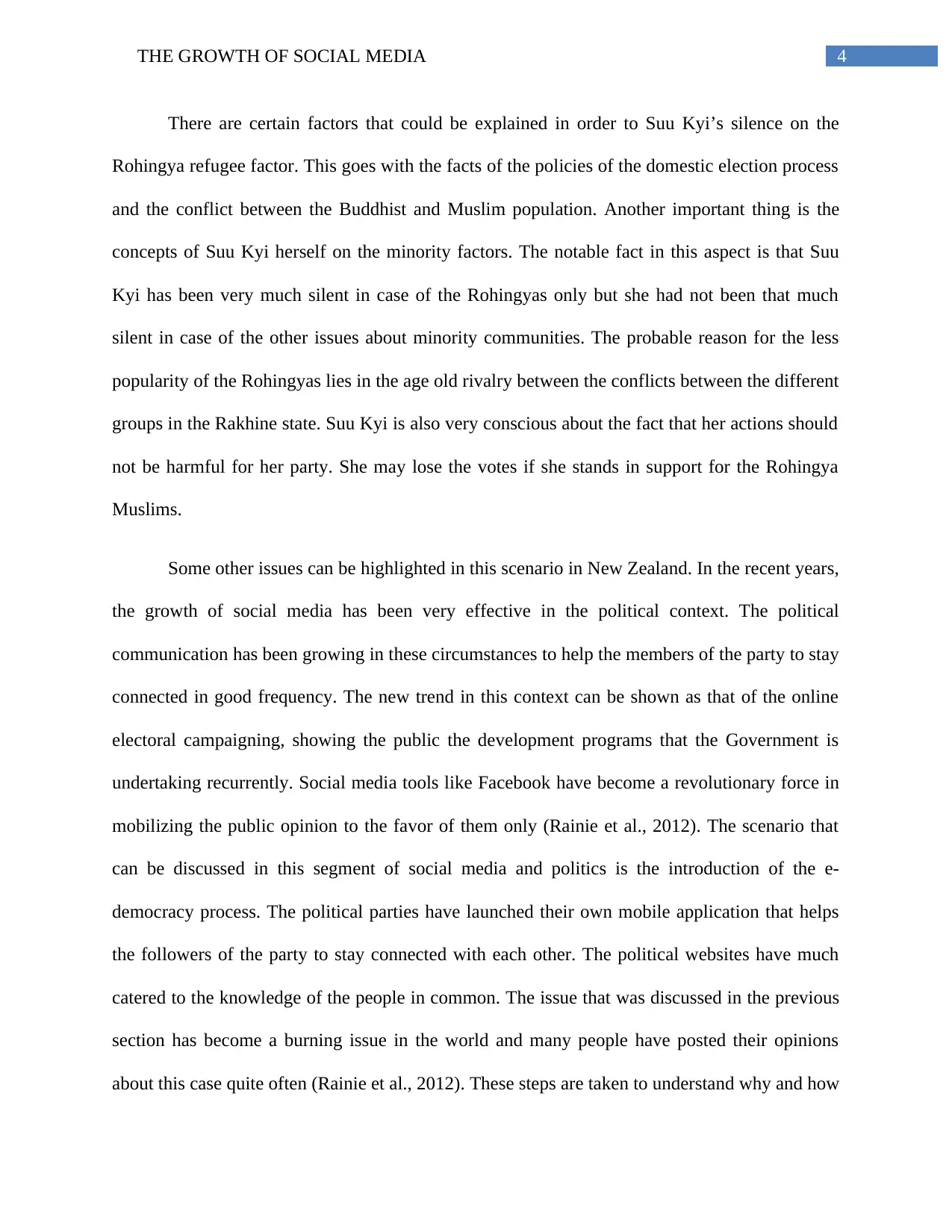
4THE GROWTH OF SOCIAL MEDIA
There are certain factors that could be explained in order to Suu Kyi’s silence on the
Rohingya refugee factor. This goes with the facts of the policies of the domestic election process
and the conflict between the Buddhist and Muslim population. Another important thing is the
concepts of Suu Kyi herself on the minority factors. The notable fact in this aspect is that Suu
Kyi has been very much silent in case of the Rohingyas only but she had not been that much
silent in case of the other issues about minority communities. The probable reason for the less
popularity of the Rohingyas lies in the age old rivalry between the conflicts between the different
groups in the Rakhine state. Suu Kyi is also very conscious about the fact that her actions should
not be harmful for her party. She may lose the votes if she stands in support for the Rohingya
Muslims.
Some other issues can be highlighted in this scenario in New Zealand. In the recent years,
the growth of social media has been very effective in the political context. The political
communication has been growing in these circumstances to help the members of the party to stay
connected in good frequency. The new trend in this context can be shown as that of the online
electoral campaigning, showing the public the development programs that the Government is
undertaking recurrently. Social media tools like Facebook have become a revolutionary force in
mobilizing the public opinion to the favor of them only (Rainie et al., 2012). The scenario that
can be discussed in this segment of social media and politics is the introduction of the e-
democracy process. The political parties have launched their own mobile application that helps
the followers of the party to stay connected with each other. The political websites have much
catered to the knowledge of the people in common. The issue that was discussed in the previous
section has become a burning issue in the world and many people have posted their opinions
about this case quite often (Rainie et al., 2012). These steps are taken to understand why and how
There are certain factors that could be explained in order to Suu Kyi’s silence on the
Rohingya refugee factor. This goes with the facts of the policies of the domestic election process
and the conflict between the Buddhist and Muslim population. Another important thing is the
concepts of Suu Kyi herself on the minority factors. The notable fact in this aspect is that Suu
Kyi has been very much silent in case of the Rohingyas only but she had not been that much
silent in case of the other issues about minority communities. The probable reason for the less
popularity of the Rohingyas lies in the age old rivalry between the conflicts between the different
groups in the Rakhine state. Suu Kyi is also very conscious about the fact that her actions should
not be harmful for her party. She may lose the votes if she stands in support for the Rohingya
Muslims.
Some other issues can be highlighted in this scenario in New Zealand. In the recent years,
the growth of social media has been very effective in the political context. The political
communication has been growing in these circumstances to help the members of the party to stay
connected in good frequency. The new trend in this context can be shown as that of the online
electoral campaigning, showing the public the development programs that the Government is
undertaking recurrently. Social media tools like Facebook have become a revolutionary force in
mobilizing the public opinion to the favor of them only (Rainie et al., 2012). The scenario that
can be discussed in this segment of social media and politics is the introduction of the e-
democracy process. The political parties have launched their own mobile application that helps
the followers of the party to stay connected with each other. The political websites have much
catered to the knowledge of the people in common. The issue that was discussed in the previous
section has become a burning issue in the world and many people have posted their opinions
about this case quite often (Rainie et al., 2012). These steps are taken to understand why and how
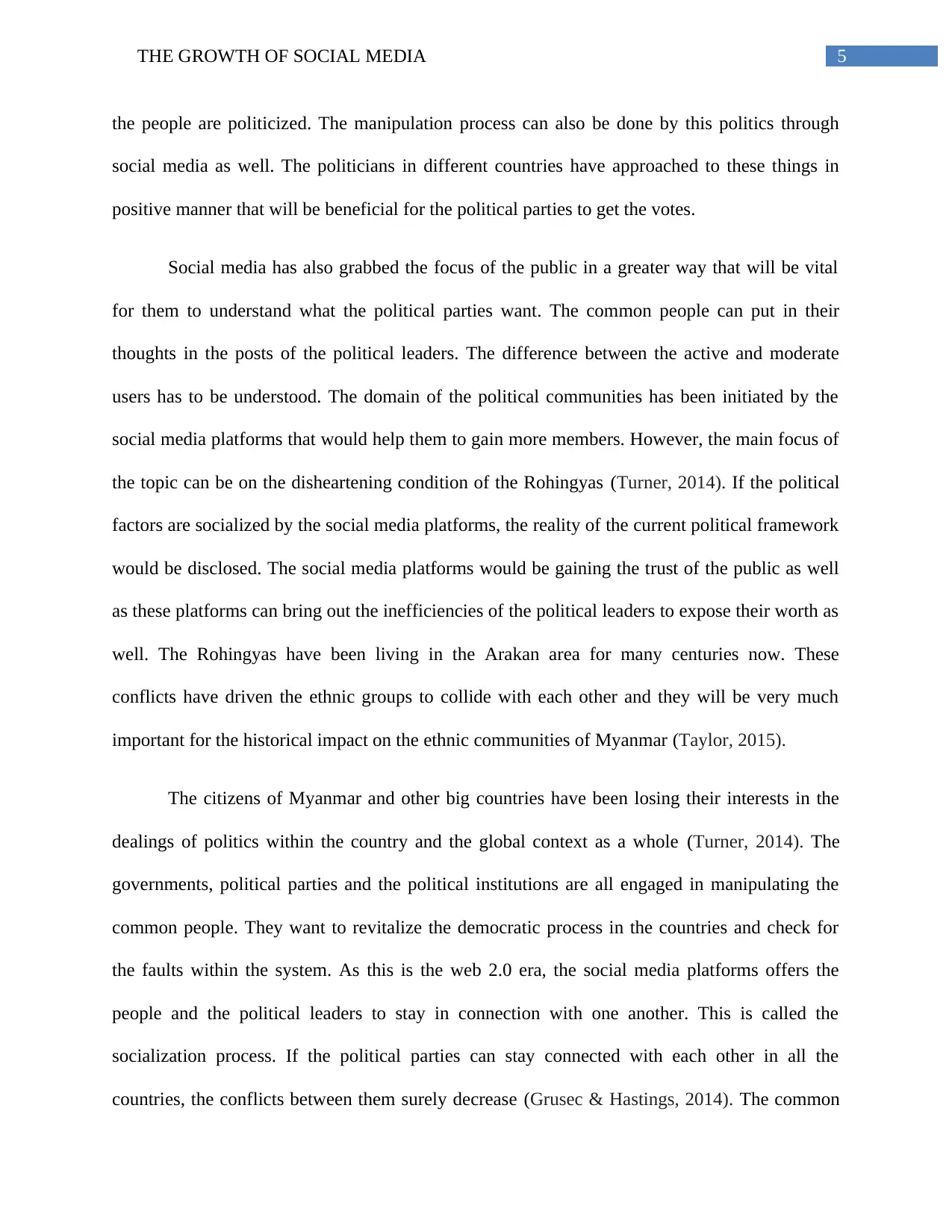
5THE GROWTH OF SOCIAL MEDIA
the people are politicized. The manipulation process can also be done by this politics through
social media as well. The politicians in different countries have approached to these things in
positive manner that will be beneficial for the political parties to get the votes.
Social media has also grabbed the focus of the public in a greater way that will be vital
for them to understand what the political parties want. The common people can put in their
thoughts in the posts of the political leaders. The difference between the active and moderate
users has to be understood. The domain of the political communities has been initiated by the
social media platforms that would help them to gain more members. However, the main focus of
the topic can be on the disheartening condition of the Rohingyas (Turner, 2014). If the political
factors are socialized by the social media platforms, the reality of the current political framework
would be disclosed. The social media platforms would be gaining the trust of the public as well
as these platforms can bring out the inefficiencies of the political leaders to expose their worth as
well. The Rohingyas have been living in the Arakan area for many centuries now. These
conflicts have driven the ethnic groups to collide with each other and they will be very much
important for the historical impact on the ethnic communities of Myanmar (Taylor, 2015).
The citizens of Myanmar and other big countries have been losing their interests in the
dealings of politics within the country and the global context as a whole (Turner, 2014). The
governments, political parties and the political institutions are all engaged in manipulating the
common people. They want to revitalize the democratic process in the countries and check for
the faults within the system. As this is the web 2.0 era, the social media platforms offers the
people and the political leaders to stay in connection with one another. This is called the
socialization process. If the political parties can stay connected with each other in all the
countries, the conflicts between them surely decrease (Grusec & Hastings, 2014). The common
the people are politicized. The manipulation process can also be done by this politics through
social media as well. The politicians in different countries have approached to these things in
positive manner that will be beneficial for the political parties to get the votes.
Social media has also grabbed the focus of the public in a greater way that will be vital
for them to understand what the political parties want. The common people can put in their
thoughts in the posts of the political leaders. The difference between the active and moderate
users has to be understood. The domain of the political communities has been initiated by the
social media platforms that would help them to gain more members. However, the main focus of
the topic can be on the disheartening condition of the Rohingyas (Turner, 2014). If the political
factors are socialized by the social media platforms, the reality of the current political framework
would be disclosed. The social media platforms would be gaining the trust of the public as well
as these platforms can bring out the inefficiencies of the political leaders to expose their worth as
well. The Rohingyas have been living in the Arakan area for many centuries now. These
conflicts have driven the ethnic groups to collide with each other and they will be very much
important for the historical impact on the ethnic communities of Myanmar (Taylor, 2015).
The citizens of Myanmar and other big countries have been losing their interests in the
dealings of politics within the country and the global context as a whole (Turner, 2014). The
governments, political parties and the political institutions are all engaged in manipulating the
common people. They want to revitalize the democratic process in the countries and check for
the faults within the system. As this is the web 2.0 era, the social media platforms offers the
people and the political leaders to stay in connection with one another. This is called the
socialization process. If the political parties can stay connected with each other in all the
countries, the conflicts between them surely decrease (Grusec & Hastings, 2014). The common
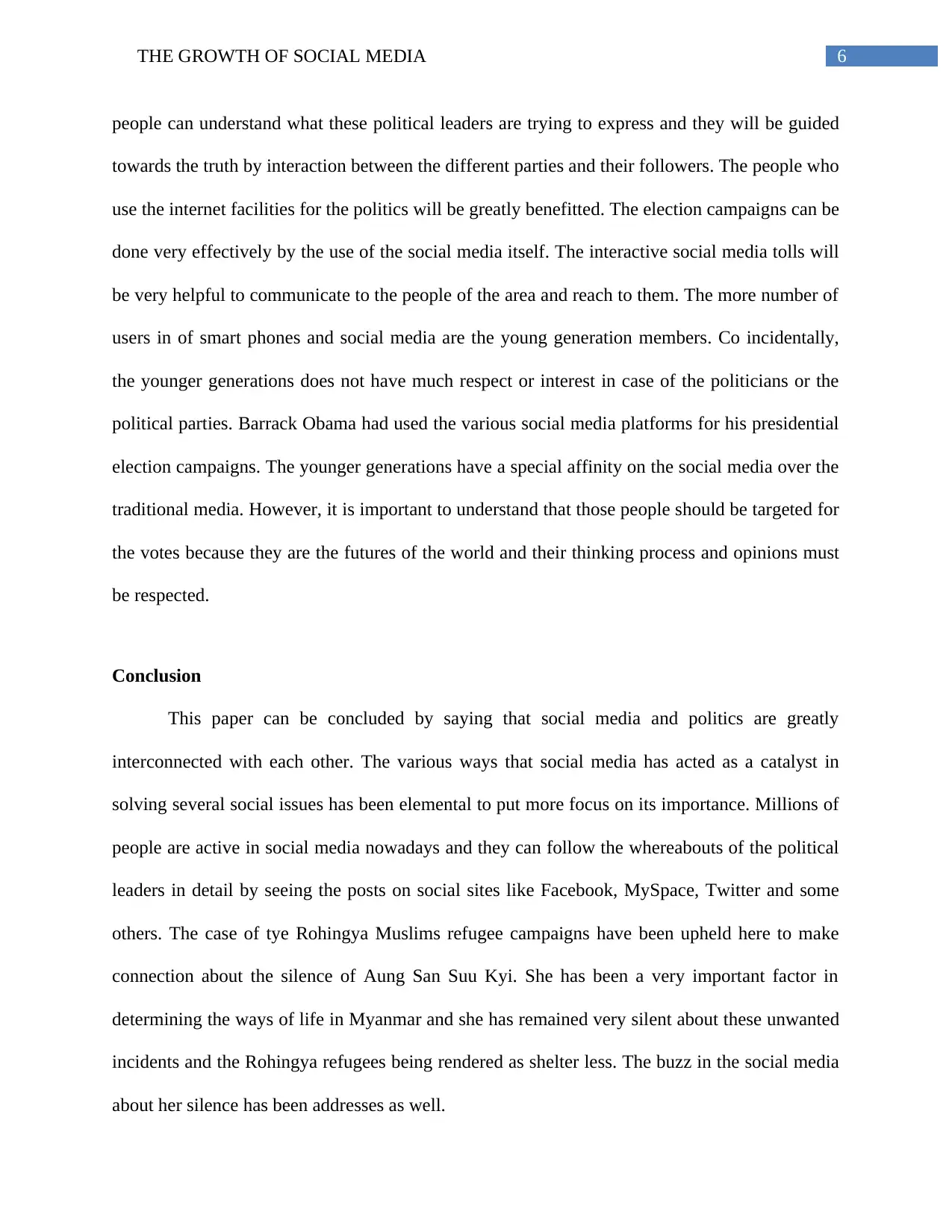
6THE GROWTH OF SOCIAL MEDIA
people can understand what these political leaders are trying to express and they will be guided
towards the truth by interaction between the different parties and their followers. The people who
use the internet facilities for the politics will be greatly benefitted. The election campaigns can be
done very effectively by the use of the social media itself. The interactive social media tolls will
be very helpful to communicate to the people of the area and reach to them. The more number of
users in of smart phones and social media are the young generation members. Co incidentally,
the younger generations does not have much respect or interest in case of the politicians or the
political parties. Barrack Obama had used the various social media platforms for his presidential
election campaigns. The younger generations have a special affinity on the social media over the
traditional media. However, it is important to understand that those people should be targeted for
the votes because they are the futures of the world and their thinking process and opinions must
be respected.
Conclusion
This paper can be concluded by saying that social media and politics are greatly
interconnected with each other. The various ways that social media has acted as a catalyst in
solving several social issues has been elemental to put more focus on its importance. Millions of
people are active in social media nowadays and they can follow the whereabouts of the political
leaders in detail by seeing the posts on social sites like Facebook, MySpace, Twitter and some
others. The case of tye Rohingya Muslims refugee campaigns have been upheld here to make
connection about the silence of Aung San Suu Kyi. She has been a very important factor in
determining the ways of life in Myanmar and she has remained very silent about these unwanted
incidents and the Rohingya refugees being rendered as shelter less. The buzz in the social media
about her silence has been addresses as well.
people can understand what these political leaders are trying to express and they will be guided
towards the truth by interaction between the different parties and their followers. The people who
use the internet facilities for the politics will be greatly benefitted. The election campaigns can be
done very effectively by the use of the social media itself. The interactive social media tolls will
be very helpful to communicate to the people of the area and reach to them. The more number of
users in of smart phones and social media are the young generation members. Co incidentally,
the younger generations does not have much respect or interest in case of the politicians or the
political parties. Barrack Obama had used the various social media platforms for his presidential
election campaigns. The younger generations have a special affinity on the social media over the
traditional media. However, it is important to understand that those people should be targeted for
the votes because they are the futures of the world and their thinking process and opinions must
be respected.
Conclusion
This paper can be concluded by saying that social media and politics are greatly
interconnected with each other. The various ways that social media has acted as a catalyst in
solving several social issues has been elemental to put more focus on its importance. Millions of
people are active in social media nowadays and they can follow the whereabouts of the political
leaders in detail by seeing the posts on social sites like Facebook, MySpace, Twitter and some
others. The case of tye Rohingya Muslims refugee campaigns have been upheld here to make
connection about the silence of Aung San Suu Kyi. She has been a very important factor in
determining the ways of life in Myanmar and she has remained very silent about these unwanted
incidents and the Rohingya refugees being rendered as shelter less. The buzz in the social media
about her silence has been addresses as well.
Secure Best Marks with AI Grader
Need help grading? Try our AI Grader for instant feedback on your assignments.
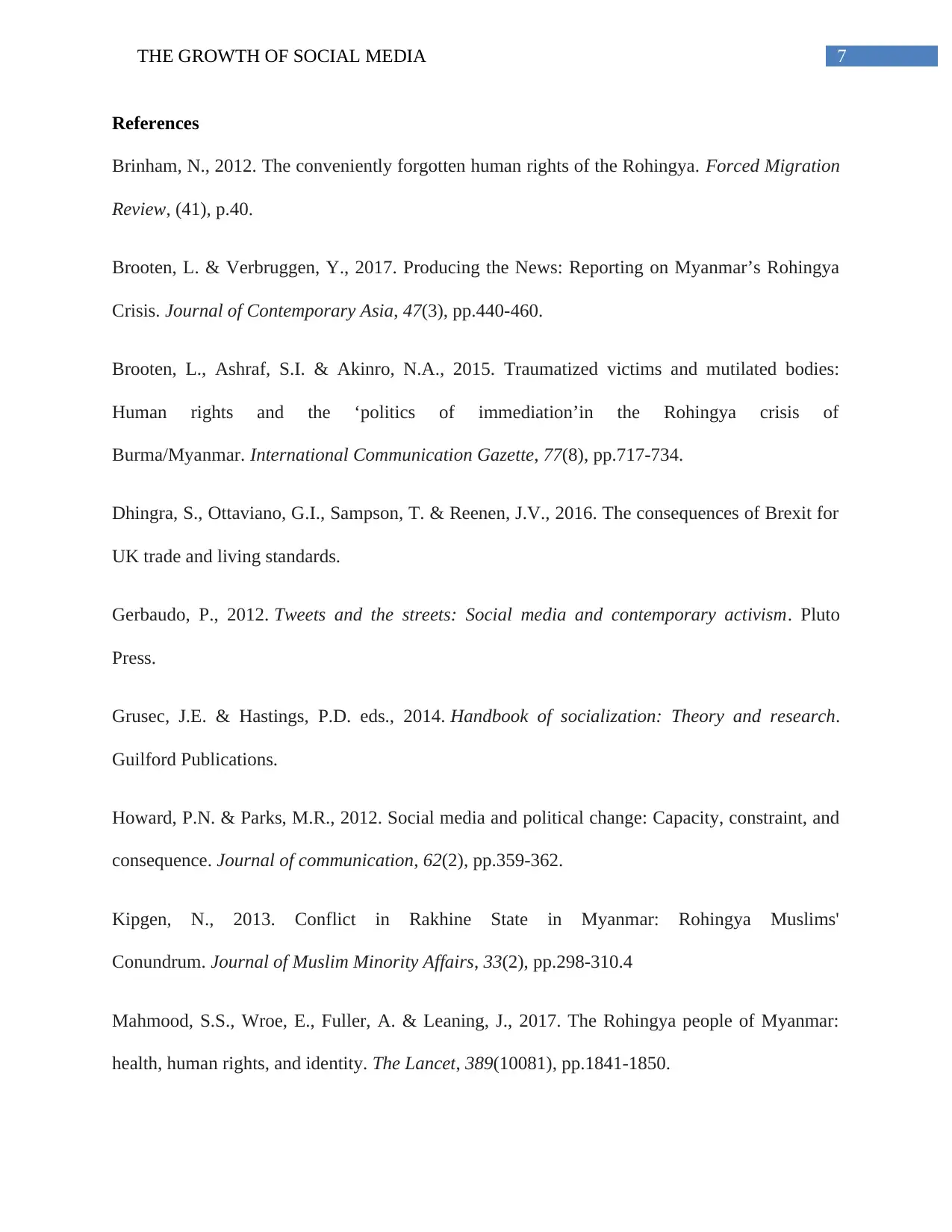
7THE GROWTH OF SOCIAL MEDIA
References
Brinham, N., 2012. The conveniently forgotten human rights of the Rohingya. Forced Migration
Review, (41), p.40.
Brooten, L. & Verbruggen, Y., 2017. Producing the News: Reporting on Myanmar’s Rohingya
Crisis. Journal of Contemporary Asia, 47(3), pp.440-460.
Brooten, L., Ashraf, S.I. & Akinro, N.A., 2015. Traumatized victims and mutilated bodies:
Human rights and the ‘politics of immediation’in the Rohingya crisis of
Burma/Myanmar. International Communication Gazette, 77(8), pp.717-734.
Dhingra, S., Ottaviano, G.I., Sampson, T. & Reenen, J.V., 2016. The consequences of Brexit for
UK trade and living standards.
Gerbaudo, P., 2012. Tweets and the streets: Social media and contemporary activism. Pluto
Press.
Grusec, J.E. & Hastings, P.D. eds., 2014. Handbook of socialization: Theory and research.
Guilford Publications.
Howard, P.N. & Parks, M.R., 2012. Social media and political change: Capacity, constraint, and
consequence. Journal of communication, 62(2), pp.359-362.
Kipgen, N., 2013. Conflict in Rakhine State in Myanmar: Rohingya Muslims'
Conundrum. Journal of Muslim Minority Affairs, 33(2), pp.298-310.4
Mahmood, S.S., Wroe, E., Fuller, A. & Leaning, J., 2017. The Rohingya people of Myanmar:
health, human rights, and identity. The Lancet, 389(10081), pp.1841-1850.
References
Brinham, N., 2012. The conveniently forgotten human rights of the Rohingya. Forced Migration
Review, (41), p.40.
Brooten, L. & Verbruggen, Y., 2017. Producing the News: Reporting on Myanmar’s Rohingya
Crisis. Journal of Contemporary Asia, 47(3), pp.440-460.
Brooten, L., Ashraf, S.I. & Akinro, N.A., 2015. Traumatized victims and mutilated bodies:
Human rights and the ‘politics of immediation’in the Rohingya crisis of
Burma/Myanmar. International Communication Gazette, 77(8), pp.717-734.
Dhingra, S., Ottaviano, G.I., Sampson, T. & Reenen, J.V., 2016. The consequences of Brexit for
UK trade and living standards.
Gerbaudo, P., 2012. Tweets and the streets: Social media and contemporary activism. Pluto
Press.
Grusec, J.E. & Hastings, P.D. eds., 2014. Handbook of socialization: Theory and research.
Guilford Publications.
Howard, P.N. & Parks, M.R., 2012. Social media and political change: Capacity, constraint, and
consequence. Journal of communication, 62(2), pp.359-362.
Kipgen, N., 2013. Conflict in Rakhine State in Myanmar: Rohingya Muslims'
Conundrum. Journal of Muslim Minority Affairs, 33(2), pp.298-310.4
Mahmood, S.S., Wroe, E., Fuller, A. & Leaning, J., 2017. The Rohingya people of Myanmar:
health, human rights, and identity. The Lancet, 389(10081), pp.1841-1850.
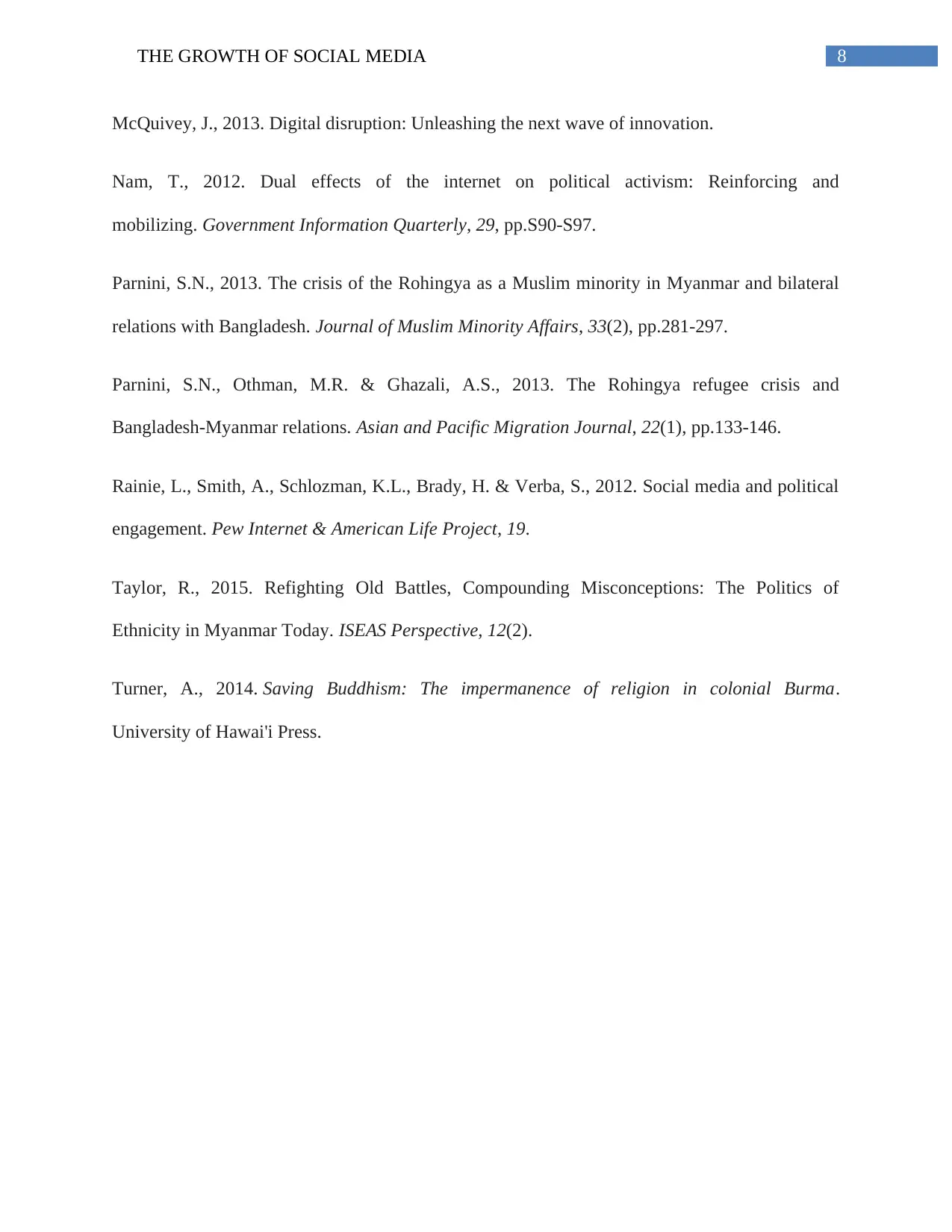
8THE GROWTH OF SOCIAL MEDIA
McQuivey, J., 2013. Digital disruption: Unleashing the next wave of innovation.
Nam, T., 2012. Dual effects of the internet on political activism: Reinforcing and
mobilizing. Government Information Quarterly, 29, pp.S90-S97.
Parnini, S.N., 2013. The crisis of the Rohingya as a Muslim minority in Myanmar and bilateral
relations with Bangladesh. Journal of Muslim Minority Affairs, 33(2), pp.281-297.
Parnini, S.N., Othman, M.R. & Ghazali, A.S., 2013. The Rohingya refugee crisis and
Bangladesh-Myanmar relations. Asian and Pacific Migration Journal, 22(1), pp.133-146.
Rainie, L., Smith, A., Schlozman, K.L., Brady, H. & Verba, S., 2012. Social media and political
engagement. Pew Internet & American Life Project, 19.
Taylor, R., 2015. Refighting Old Battles, Compounding Misconceptions: The Politics of
Ethnicity in Myanmar Today. ISEAS Perspective, 12(2).
Turner, A., 2014. Saving Buddhism: The impermanence of religion in colonial Burma.
University of Hawai'i Press.
McQuivey, J., 2013. Digital disruption: Unleashing the next wave of innovation.
Nam, T., 2012. Dual effects of the internet on political activism: Reinforcing and
mobilizing. Government Information Quarterly, 29, pp.S90-S97.
Parnini, S.N., 2013. The crisis of the Rohingya as a Muslim minority in Myanmar and bilateral
relations with Bangladesh. Journal of Muslim Minority Affairs, 33(2), pp.281-297.
Parnini, S.N., Othman, M.R. & Ghazali, A.S., 2013. The Rohingya refugee crisis and
Bangladesh-Myanmar relations. Asian and Pacific Migration Journal, 22(1), pp.133-146.
Rainie, L., Smith, A., Schlozman, K.L., Brady, H. & Verba, S., 2012. Social media and political
engagement. Pew Internet & American Life Project, 19.
Taylor, R., 2015. Refighting Old Battles, Compounding Misconceptions: The Politics of
Ethnicity in Myanmar Today. ISEAS Perspective, 12(2).
Turner, A., 2014. Saving Buddhism: The impermanence of religion in colonial Burma.
University of Hawai'i Press.
1 out of 9
Related Documents
Your All-in-One AI-Powered Toolkit for Academic Success.
+13062052269
info@desklib.com
Available 24*7 on WhatsApp / Email
![[object Object]](/_next/static/media/star-bottom.7253800d.svg)
Unlock your academic potential
© 2024 | Zucol Services PVT LTD | All rights reserved.





